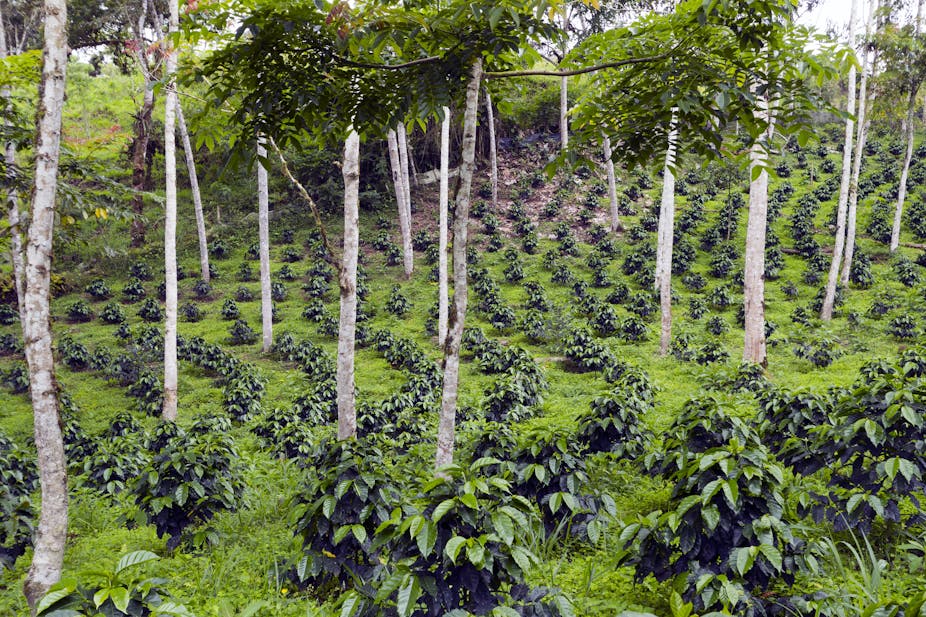“Agroforestry” – the practice of having trees as part of farms – is as old as agriculture itself. But as a field of scientific enquiry and policy making, it’s now marking its 40th birthday.
In 1978 the International Council for Research in Agro-Forestry was created to document the use of trees on farms – as a source of income, food and for a healthy environment – and spread information about it. Research gradually became a stronger focus and today it is known as the World Agroforestry Centre.
It’s an important area of research because more than 40% of the worlds’ agricultural lands have at least 10% tree cover. Because the interactions between trees, soils, crops and livestock can be positive or negative, their relationship must be balanced and understood.
To mark this anniversary my colleagues and I from the World Agroforestry Centre, launched a book which takes stock of the science produced and what else needs to be done. A total of 80 authors looked at approaches to agroforestry and how it has contributed to the transformation of rural livelihoods and landscapes.
The key lesson from agroforestry is that tree cover needs to be understood and managed as part of a landscape, harmonising agricultural and forestry policies. This is important because they cover so much land and are vital for the environment and livelihoods.
Having trees on farms has huge benefits for farmers. It could mean more income, a more buffered climate, shelter from winds and rain and, because of tree roots and leaf litter, soil is protected and nurtured.
With the current global push for “climate-smart” policies, agroforestry has presented itself as a way forward.
The beginnings
The first section of the book reviews the science of trees, soils and their interactions with crops.
Agroforestry research had to first establish that, contrary to the way agriculture and forestry was presented by policymakers and in policy as separate worlds, it exists.
There’s a relationship between trees and crops that happens in many places, in many forms, involving at least 600 species of trees worldwide.
But because agriculture and forestry were treated separately in policies, there were challenges in how trees on farms should be managed. For instance, farmers with a lot of trees on their land often got caught in forestry rules in terms of how they could use them.
An example of this was that many francophone African countries inherited laws at independence which declared that all trees belonged to the state. This meant farmers started to remove them where they could, because trees compete with crops for resources like water, leading to soil degradation.
The policy only changed after farmers in Niger found ways to circumvent the rules and show that farmers could own trees and land would regenerate as a result. Other countries in the Sahel followed suit.
Policymakers eventually began to change their views when they understood how farmers, trees, forests and water interacted at the landscape scale.
Transformations
The second section of the book looks at six landscapes around the world where agroforestry actions by farmers, supported by scientists, helped local transformations to happen.
One example, where local projects inspired change elsewhere, was in Shinyanga, northern Tanzania. Drought, overgrazing and political changes had led to forest loss and land damage. A project – between government, the World Agroforestry Centre, International Union for Conservation of Nature and local partners – successfully restored 370,000 hectares of land.
Key lessons from this project were to use land practices that contributed to livelihoods (like planting trees that would bear fruits) – and linking planning to national policies.
Examples like this began to show policymakers that bridges are needed between forest-based institutions and agricultural ones. It also showed how agroforestry can contribute to current global issues of focus – like climate change and the Sustainable Development Goals. For example, growing plants with oil-rich seeds, like Jatropha curcas a flowering plant native to the American tropics, which can produce biofuel (fuel produced from living matter). Or growing certain trees in areas because they can help manage water flows.
The future
The final part of the book suggests a way forward for the communication between science and policymakers.
Scientific knowledge can help in four stages of a policy process:
Exploring new issues and sorting out which ones deserve to be on the agenda for public discussions
Identify the underlying causes that need to be addressed in policy commitments
Clarify the trade-offs that any policy implementation will face, and ways to make these manageable
Setting up ways to monitor change, so that there still is space for innovative solutions.
The book highlights that land use policies must connect local action with global concerns. It demonstrates the potential that agroforestry has for the Sustainable Development Goal agenda.

